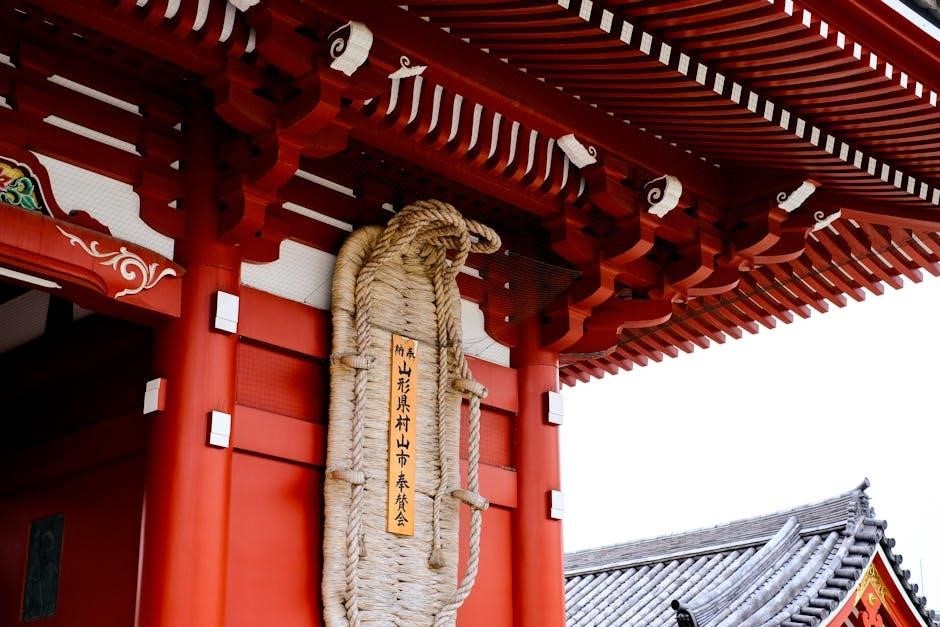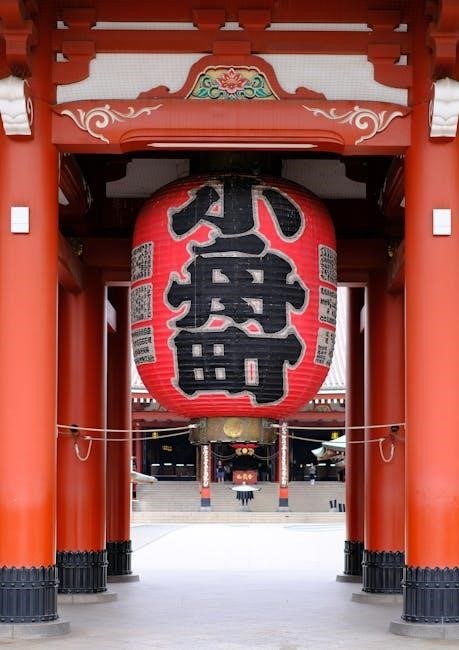
japan tv guide
Japanese TV offers a vibrant mix of entertainment, culture, and information, reflecting the country’s diverse society․ From dramas to anime, it showcases unique storytelling and global pop culture influence, accessible through various platforms․
1․1 Overview of Japanese Television
Japanese television features a diverse range of programming, including dramas, anime, variety shows, and news․ Major networks like NHK, Fuji TV, and TV Asahi dominate the landscape, offering both entertainment and educational content․ Regional broadcasters also provide local programming, ensuring a wide reach․ The TV guide highlights popular genres, catering to all audiences, from J-Dramas to anime, and variety shows that blend humor and culture․ This vibrant mix makes Japanese TV a reflection of its dynamic society and global influence․
1․2 History of TV in Japan
Television in Japan began in the late 1950s, with the first broadcasts by NHK in 1953․ The medium quickly gained popularity, becoming a cornerstone of Japanese culture․ Color TV emerged in the 1960s, with the 1964 Tokyo Olympics marking a significant milestone․ The 1970s and 1980s saw the rise of commercial stations like Fuji TV and TV Asahi, diversifying content․ Digital broadcasting began in the early 2000s, with a full shift by 2011․ Today, Japan boasts advanced TV technology, including 4K and 8K resolutions, solidifying its place as a global leader in broadcasting․
1․3 Popularity of TV in Japanese Culture
Television remains a central part of Japanese daily life and culture, offering diverse genres like J-Dramas, anime, and variety shows․ Its widespread popularity stems from its ability to cater to all age groups, blending entertainment with cultural insights․ TV is also a key source for news, education, and social trends, making it an essential medium for staying connected to Japanese society and its evolving values․
Major TV Networks in Japan
Japan’s major TV networks include NHK, Fuji TV, TV Asahi, and NTV, each offering diverse programming․ These networks dominate the media landscape, providing entertainment, news, and cultural content․
2․1 NHK (Japan Broadcasting Corporation)
NHK, Japan’s public broadcaster, offers high-quality programming since 1926․ It provides news, documentaries, dramas, and cultural shows․ Its terrestrial channels include General TV and Educational TV, while NHK World-Japan reaches global audiences․ Popular series like Taiga and Asadora highlight its storytelling excellence․ NHK prioritizes education and culture, making it a trusted source for both domestic and international viewers․
2․2 Commercial Key Stations (e․g․, Fuji TV, TV Asahi)
Commercial key stations like Fuji TV and TV Asahi dominate Japan’s private broadcasting landscape․ Established in 1957, Fuji TV is renowned for its entertainment-focused programming, including popular dramas, variety shows, and sports coverage․ TV Asahi, founded in 1957, specializes in news and documentaries but also produces hit dramas and anime․ Both networks play a significant role in shaping Japanese pop culture and entertainment, offering diverse content that appeals to a wide audience․
2․3 Regional Broadcasters
Regional broadcasters in Japan play a vital role in providing localized content tailored to specific areas․ These stations often focus on local news, community events, and regional interests, ensuring diverse programming․ While they collaborate with major networks for national content, their strength lies in catering to unique local needs․ For example, stations in Hokkaido may emphasize agricultural or seasonal programming, reflecting the region’s distinct culture and lifestyle, making them indispensable for local audiences seeking relevant information and entertainment․

Popular Genres on Japanese TV
Japanese TV features diverse genres, including dramas, anime, variety shows, and news․ These cater to wide audiences, blending entertainment, culture, and information, making TV a central part of daily life․
3․1 Drama (J-Drama)
Japanese dramas, or J-Dramas, are a cornerstone of Japanese television, offering compelling storylines that often blend emotional depth with cultural insights․ These serialized shows typically run for a single season, featuring relatable characters and themes that resonate with audiences․ From romantic tales to workplace dramas, J-Dramas highlight everyday life, societal issues, and human connections․ Their concise format and high production quality have made them a global favorite, showcasing Japan’s unique storytelling style and cultural values to viewers worldwide․
3․2 Anime
Anime is a cornerstone of Japanese television, offering vibrant animation and diverse genres like romance, action, and sci-fi․ These shows often feature intricate storylines and memorable characters, appealing to audiences of all ages․ Many anime series are adapted from popular manga and light novels, blending cultural themes with universal appeal․ With its unique art style and creative storytelling, anime has become a global phenomenon, making it one of Japan’s most influential cultural exports and a staple of modern entertainment․
3․3 Variety Shows
Japanese variety shows are a cornerstone of entertainment, blending humor, games, and celebrity appearances․ These programs often feature unique formats, such as comedic challenges, trivia, and physical competitions, making them highly engaging․ Shows like Gaki no Tsukai and Ariyoshiriori captivate audiences with their light-hearted and often absurd humor․ Variety shows are a cultural staple, providing both laughter and insight into Japanese pop culture, and remain a major draw for viewers of all ages․
3․4 News and Current Affairs
Japanese TV offers comprehensive news and current affairs programs, providing in-depth coverage of domestic and international events․ NHK, as a public broadcaster, plays a key role in delivering reliable and impartial news․ These shows often focus on politics, social issues, and economic trends, catering to both local and international audiences․ Many programs also include multilingual support, ensuring accessibility for non-Japanese speakers․ News shows are a vital source of information, reflecting Japan’s commitment to keeping its citizens informed and engaged with global events․

Must-Watch TV Shows
Japanese TV features a diverse range of must-watch shows, including iconic dramas, beloved anime, and engaging variety programs that cater to all audiences and interests․
4․1 Flagship Dramas
Japanese flagship dramas, known as J-Dramas, captivate audiences with compelling narratives and relatable characters․ Popular series like Tokyo Revengers and Hanzawa Naoki blend emotional depth with cultural insights, making them must-watch․ These dramas often explore themes of family, romance, and societal issues, resonating deeply with viewers․ Their well-crafted storytelling and strong character development have earned them both domestic acclaim and international recognition, solidifying their place as cornerstones of Japanese television․

4․2 Iconic Anime Series
Iconic anime series like Dragon Ball Z, Naruto, and One Piece have become cultural phenomena in Japan and worldwide․ These shows blend action, emotion, and fantasy, captivating audiences of all ages․ Their intricate storylines and memorable characters have made them staples of Japanese television․ Anime series often explore themes of perseverance, friendship, and self-discovery, resonating deeply with viewers․ They are a cornerstone of Japan’s pop culture, influencing global entertainment and attracting a diverse fan base across generations․
4․3 Popular Variety Programs
Japanese variety programs, such as Terrace House and Ariyoshi’s Japanese Dictionary, are highly entertaining and culturally insightful․ These shows often feature humor, games, and celebrity appearances, blending light-hearted fun with unique perspectives on Japanese society․ They appeal to a wide audience, offering a mix of comedy, trivia, and real-life scenarios․ Variety programs are a staple of Japanese TV, providing both entertainment and cultural reflections that resonate with viewers of all ages․

4․4 Cultural and Documentary Shows
Cultural and documentary shows on Japanese TV offer deep insights into the country’s heritage and modern life․ Programs like Navigating Language Barriers in Japan and documentaries on traditional crafts highlight unique aspects of Japanese society․ These shows often explore historical traditions, contemporary issues, and cultural nuances, providing viewers with a rich understanding of Japan’s diverse identity․ They serve as a bridge between past and present, educating and captivating audiences with authentic storytelling and visual narratives․
Streaming Services in Japan
Japan’s streaming services, like Netflix Japan and Amazon Prime Video, offer diverse content, including J-dramas, anime, and international shows, catering to both local and global audiences․
5․1 Netflix Japan
Netflix Japan is a leading streaming platform offering a wide range of content, including popular J-dramas, anime, and international shows․ It features exclusive Japanese originals like “Terrace House” and “The Naked Director․” With multi-language subtitles and dubbing, it caters to both local and global audiences․ The platform regularly updates its library, ensuring fresh entertainment options․ Its user-friendly interface and personalized recommendations make it a favorite among viewers seeking diverse and high-quality content in Japan․
5․2 Amazon Prime Video Japan
Amazon Prime Video Japan offers a diverse library of content, including Japanese movies, dramas, and anime․ It features exclusive Amazon Originals like “The Wheel of Time” and “Re:From․” The platform supports 4K Ultra HD streaming and multi-language subtitles, enhancing viewer experience; As part of Amazon Prime membership, it provides additional perks like free shipping and music streaming․ Prime Video caters to both Japanese and global audiences, making it a popular choice for high-quality entertainment in Japan․
5․3 Other Local Streaming Platforms
Beyond global giants, Japan boasts local streaming platforms like U-Next and Hulu Japan․ U-Next offers a vast library of Japanese and international content, including anime and dramas, with a focus on 4K streaming․ Hulu Japan specializes in TV dramas, variety shows, and movies, catering to local tastes․ These platforms provide niche content, ensuring diverse entertainment options for audiences in Japan, while competing with global services like Netflix and Amazon Prime․ They are popular for their tailored content and regional accessibility․

Cultural Aspects of Japanese TV
Japanese TV reflects deep cultural values, blending tradition with modernity․ Unique formats, societal norms, and language nuances create a distinct viewing experience, enriching global audiences․
6․1 Unique TV Formats
Japanese TV boasts distinctive formats blending tradition and modernity․ Variety shows, often combining comedy, music, and games, dominate primetime․ Unique interactive game programs and live music shows like Music Station captivate audiences․ These formats emphasize family-friendly content, showcasing Japanese creativity and cultural nuances, while often featuring celebrities and quirky challenges that reflect societal trends and values, making them a cornerstone of Japanese entertainment․
6․2 Role of TV in Japanese Pop Culture
TV plays a central role in shaping Japanese pop culture, influencing music, fashion, and trends․ Popular dramas and variety shows often drive viral trends, while anime and music programs showcase emerging talents․ These platforms reflect and amplify societal values, making TV a key driver of cultural identity․ Its impact extends globally, with Japanese TV content being exported and inspiring fans worldwide, highlighting its significance in modern Japanese society and entertainment․
6․3 Language and Accessibility
Japanese TV programming often includes subtitles in Japanese, aiding non-native speakers․ Some shows offer multilingual support, while others incorporate sign language for accessibility․ Language barriers can challenge international viewers, but streaming platforms increasingly provide English subtitles․ This makes Japanese TV more accessible globally, bridging cultural gaps and enabling wider audiences to enjoy its diverse content․ These efforts highlight Japan’s commitment to inclusivity in its media, ensuring TV remains a universal medium․

How to Access Japanese TV

Japanese TV can be accessed via satellite, cable, or streaming services․ VPNs also enable international viewers to watch Japanese TV content globally․
7․1 Satellite and Cable TV
Satellite and cable TV remain popular ways to access Japanese TV․ Major networks like NHK, Fuji TV, and TV Asahi are widely available․ Regional broadcasters also offer local content․ Subscriptions often include a mix of entertainment, news, and cultural programs․ Satellite TV provides access to premium channels, while cable TV is more affordable․ Both options ensure reliable access to live programming, making them ideal for viewers who prefer traditional TV viewing experiences․
7․2 Streaming Services
Streaming services in Japan have grown significantly, offering diverse content․ Netflix Japan and Amazon Prime Video provide popular J-dramas, anime, and variety shows․ Local platforms like Hulu Japan and U-Next cater to niche audiences with exclusive content․ These services allow viewers to access Japanese TV shows on-demand, with many offering multi-language support․ Affordable subscription plans and high-quality streaming make them a favorite among both locals and expats, revolutionizing how Japanese TV is consumed globally․

7․3 Watching Japanese TV Abroad
Accessing Japanese TV abroad is now easier than ever, thanks to global streaming platforms․ Services like Netflix Japan and Amazon Prime Video offer a wide range of Japanese content, including dramas, anime, and variety shows․ Additionally, free platforms like Crunchyroll and Funimation provide simulcasts of popular anime․ For live TV, some channels offer international subscriptions, while VPNs can help bypass geo-restrictions․ This allows global audiences to enjoy Japanese TV’s unique programs and stay connected to its vibrant culture․

Future Trends in Japanese TV
Japanese TV is evolving with advancements in digital broadcasting and streaming․ Niche content and global collaborations are expected to rise, catering to diverse audiences worldwide․
8․1 Shift to Digital Broadcasting
Japan’s transition to digital broadcasting is revolutionizing TV experiences․ With the rise of 4K and 8K resolution, viewers enjoy ultra-high-definition content․ NHK leads the charge with cutting-edge technology, offering immersive experiences․ Streaming platforms like Netflix Japan are also influencing traditional TV, pushing broadcasters to adopt on-demand models․ This shift enhances accessibility and picture quality while fostering innovation in content delivery, ensuring Japan remains a global leader in broadcasting technology․
8․2 Rise of Niche Content
The rise of niche content in Japanese TV caters to specific audiences, fostering diversity in programming․ Streaming platforms like Netflix Japan and Amazon Prime Video Japan offer tailored content, from unique anime sub-genres to specialized dramas․ This shift reflects changing viewer preferences, enabling creators to experiment with innovative formats․ Niche content not only satisfies dedicated fanbases but also encourages cultural exchange by highlighting lesser-known aspects of Japanese society and entertainment, making TV more inclusive and engaging for diverse viewers globally․
8․3 Global Collaboration
Global collaboration is reshaping Japanese TV, with international platforms like Netflix and Amazon Prime partnering with local creators․ These collaborations produce diverse content blending Japanese culture with global themes, attracting both domestic and international audiences․ Such efforts enhance cross-cultural storytelling, introducing Japanese talent and narratives to worldwide viewers․ This trend fosters innovation, cultural exchange, and mutual growth, positioning Japanese TV as a key player in the global entertainment landscape while preserving its unique cultural identity and creative excellence․
Tips for Watching Japanese TV
Enhance your viewing experience by using streaming services like Netflix and Amazon Prime for diverse content․ Understanding cultural nuances and improving language skills through shows like dramas and anime can deepen your appreciation of Japanese TV, making it both entertaining and educational․
9․1 Learning Japanese Through TV
Watching Japanese TV is an excellent way to immerse yourself in the language and culture․ Start with shows featuring English subtitles to improve comprehension․ Pay attention to context, intonation, and common phrases․ Dramas and variety shows often use everyday language, making them ideal for learners․ Anime can also introduce unique expressions and cultural nuances․ Regular viewing helps build vocabulary and pronunciation skills, enhancing your overall language proficiency in a fun and engaging manner․
9․2 Understanding Cultural References
Japanese TV often includes cultural references that may not be immediately clear to non-native viewers․ These can range from historical nods to modern social norms․ Paying attention to context and subtle cues helps decode these references․ Using subtitles or guides can enhance understanding․ Recognizing these elements deepens your appreciation of Japanese culture and makes watching TV a more enriching experience․ It also highlights the unique aspects of Japanese society and traditions, making each show a cultural learning opportunity․
9․3 Staying Updated with TV Guides
Staying updated with Japanese TV guides is essential for navigating the diverse programming․ Printed TV guides and online platforms provide detailed listings, helping viewers plan their schedules․ Many guides include subtitles and descriptions in both Japanese and English, aiding non-native speakers․ Additionally, apps and websites offer personalized recommendations based on viewer preferences․ Regularly checking these resources ensures you never miss popular shows or new releases, keeping your viewing experience fresh and engaging․